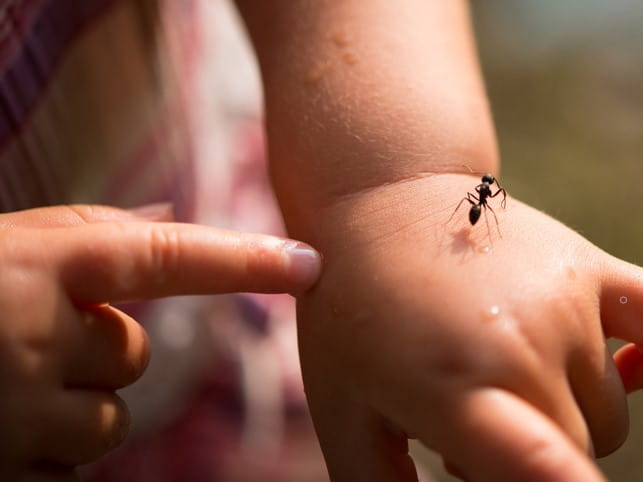Stung by an Ant?

The Bottom Line
Ant stings are common but rarely serious unless they are from imported fire ants. Problems can occur with multiple stings or with allergic reactions.

The Full Story
There are thousands of species of ants. Ants belong to the order Hymenoptera just like bees and wasps. All have antennae to sense the world around them, 3 pairs of legs, a heart, and a nervous system. Female bees, wasps, and stinging ants also share the ability to sting with a special adaptation on their abdomen.
All types of ants can bite humans and some can spray noxious chemicals, but most of these effects will go unnoticed. In the US, there are three broad categories of ants that can sting. The common names for these ants are fire ants, harvester ants, and oak ants. These ants are unique because they can deliver a painful sting that is quite noticeable. Fire ants are regarded as the most aggressive, potentially delivering a higher number of stings.
The most common fire ants in the US were unintentionally imported from South America. They are referred to as imported fire ants. Imported fire ants currently inhabit the southeastern US as far west as Texas and as far north as southern coastal Virginia with a few pockets in California. Imported fire ants currently cannot survive the hard freezes that occur in northern states and they also cannot survive very dry climates. Despite these limitations, imported fire ants are predicted to continue spreading northward and westward.
Ant colonies are highly organized and some ants have the duty of monitoring for danger. If they sense a threat, a message is passed to the colony, and the ants will swarm. The assault begins as an ant bites onto the perceived enemy. Once it has bitten and latched on, the ant will typically sting repeatedly (on average 7-8 times) in a circular pattern around the bite site by pivoting its abdomen. Initially, the venom causes a burning sensation, swelling, and pain at the sting site. However, sting sites can develop into pustules (pus-filled blisters) that can linger for a couple of weeks. The ant venom causes localized cell death, and the pustules are the result of our immune systems cleaning up the cell debris. Thanks to the antimicrobial nature of the venom, the pustules are usually sterile and should not be popped.
Although uncommon, a person can be allergic to ant stings. These reactions can become worse over time with subsequent stings. Serious reactions are more common in children because their immune systems respond to the stings more than those of adults. Imported fire ant venom contains a protein similar to those found in wasp venom, which means there could be some cross-reactivity in those with allergies to wasp stings. Signs of a severe allergy include trouble breathing and swelling of the face or lips.
Ants can sting multiple times, so brush them off as soon as you notice them to keep them from biting and stinging again. Wash the area with soap and water. A cool compress should be applied, and nonprescription pain relievers can be taken.
Ants might seem to be a nuisance but they play a vital role in the earth's ecosystem. They help break down organic matter and are natural soil aerators like earthworms. Ants have been on the earth since before the time of dinosaurs and are not going away. Expect to hear about more imported fire ant spread in the years to come.
If you have been bitten or stung by an ant or have questions about ant bites and stings, check the webPOISONCONTROL® online tool for guidance or call Poison Control at 1-800-222-1222. Whether you log on or call, expert assistance is available 24 hours a day.
Pela Soto, PharmD, BSHS, BS
Certified Specialist in Poison Information
Kristina Yee, PharmD
Certified Specialist in Poison Information
Poisoned?
Call 1-800-222-1222 or
Prevention Tips
- Avoid getting close to or disturbing anthills.
- If someone falls on or near an anthill, help them move away as quickly as possible. Brush off any clinging ants.
- If a person with a known severe allergy to ant stings is stung, do not wait for symptoms to occur. Go to an ER.
This Really Happened
An 81-year-old woman was ejected from her car and lost consciousness during a motor vehicle accident. When help came, they saw many fire ants on her trunk and arms. She was hospitalized for the injuries sustained in the car accident and was found to have over 50 sting sites. They were red with crusted pustules. She did not have an allergic reaction to the multiple stings, and her wounds healed by the time she was released from the hospital.
For More Information
Bees, ants, wasps, and similar insects. Insectidentification.org; 2018 [accessed 31 Aug 2018].
Insect bites and stings: first aid. Rochester MN: Mayo Clinic; 17 Feb 2018 [accessed 3o Aug 2018].
References
Fisher BL, Cover SP. Ants of North America: a guide to the genera. Berkeley CA: University of California Press; 2007.
Reschly MJ, Ramos-Caro FA, Mathes BM. Multiple fire ant stings: report of 3 cases and review of the literature. Cutis 2000;66:179-82.
Resh VH, Cardé RT, editors. Encyclopedia of insects. 2nd ed. Burlington MA: Academic Press; 2009.
Poisoned?
Call 1-800-222-1222 or
Prevention Tips
- Avoid getting close to or disturbing anthills.
- If someone falls on or near an anthill, help them move away as quickly as possible. Brush off any clinging ants.
- If a person with a known severe allergy to ant stings is stung, do not wait for symptoms to occur. Go to an ER.
This Really Happened
An 81-year-old woman was ejected from her car and lost consciousness during a motor vehicle accident. When help came, they saw many fire ants on her trunk and arms. She was hospitalized for the injuries sustained in the car accident and was found to have over 50 sting sites. They were red with crusted pustules. She did not have an allergic reaction to the multiple stings, and her wounds healed by the time she was released from the hospital.
